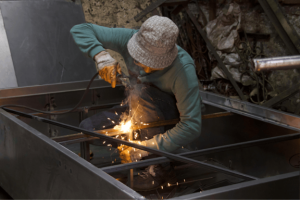Last Updated on October 30, 2025 by teamobn
Evaluating your roof’s condition, setting a realistic budget, and deciding between DIY or professional help are vital first steps in a smart roof tear-off. You’ll need to research local codes and permits to secure compliance and choose the right materials to maximize both cost-effectiveness and durability.
Considering recycling options and implementing safety measures is essential, but how do you assure quality and value for your investment? Of course, before you dive in, it pays to research the roof tear off cost for your project, so you can budget smart and avoid surprises.
Evaluating your roof’s condition, setting a realistic budget, and deciding between DIY or professional help are vital first steps in a smart roof tear-off. You’ll also want to research local codes and permits to stay compliant and choose materials that balance cost and durability.
Considering recycling options and safety measures is essential for both savings and peace of mind. Of course, before you dive in, it pays to research the roof tear off cost for your project, so you can budget smart and avoid surprises.
If you’re still unsure whether replacement is truly necessary, review the key signs that indicate it’s time to replace your roof to validate your next steps.
In this article we’ll explore the various aspects and requirements you will need to consider before moving forward.
Contents
- 1 Evaluate Your Current Roof Condition
- 2 Set a Realistic Budget
- 3 Decide Between DIY and Hiring Professionals
- 4 Research Local Building Codes and Permits
- 5 Choose the Right Roofing Materials
- 6 Compare Contractor Estimates
- 7 Plan for Unforeseen Expenses
- 8 Timing Your Project for Cost Savings
- 9 Recycle and Reuse Materials When Possible
- 10 Safety Measures and Precautions
- 11 Monitor the Project’s Progress
- 12 Inspect the Finished Roof
Evaluate Your Current Roof Condition
Before starting a roof tear-off, it’s vital to thoroughly evaluate your current roof condition, as this will inform your project scope and budget.
Begin by inspecting the shingles for curling, cracking, or missing pieces, which could indicate underlying damage. Check for sagging areas, a sign of structural issues that may require professional assessment.
Examine the flashing around chimneys, vents, and skylights for corrosion or gaps. Inside, look for water stains or mold on ceilings, a potential sign of leaks.
Don’t overlook the attic; proper ventilation and insulation are important for preventing moisture buildup. Use a moisture meter to detect hidden dampness.
Document all findings with photographs. This extensive evaluation guarantees you’re prepared for the extent and cost of necessary repairs or replacements.
Set a Realistic Budget
Having thoroughly evaluated your roof’s current condition, you’re now equipped with the necessary knowledge to set a realistic budget for your roof tear-off project.
Start by calculating the square footage of your roof and determining the cost of materials needed. Factor in the price of shingles, underlayment, nails, and any additional components required.
Don’t forget to include the cost of permits, which can vary by location. Consider the potential need for structural repairs, as these can greatly impact your budget.
It’s prudent to allocate a contingency fund—typically 10-20% of the total project cost—to cover unexpected expenses.
Detailed cost estimation guarantees financial preparedness, allowing you to manage your project efficiently without compromising quality or facing unwelcome surprises.
Decide Between DIY and Hiring Professionals

When starting on a roof tear-off project, deciding whether to undertake the task yourself or hire professionals is crucial.
Evaluate your skill level and the complexity of your roof. If you’ve got experience and the necessary tools, a DIY approach might save costs. However, consider the risks, such as potential injuries or improper installation, which could lead to further expenses.
On the other hand, hiring professionals guarantees expertise and efficiency. They’ll handle safety measures and have access to quality materials.
Request multiple quotes and check references to find a reputable contractor. Consider time constraints; professionals complete tasks faster, reducing potential weather-related delays.
Weighing these factors will help you make an informed decision that aligns with your budget and needs.
Research Local Building Codes and Permits
After deciding between DIY and professional help, it’s important to understand local building codes and permits to guarantee compliance.
Begin by contacting your local building department to get specific information. Here are three key steps:
- Identify Permit Requirements: Determine if your project requires a permit. Some areas mandate permits for roof tear-offs due to structural and safety concerns.
- Understand Code Specifications: Familiarize yourself with local building codes. These may dictate specific materials, installation methods, and safety measures, ensuring your project meets legal standards.
- Review Inspection Procedures: Learn about inspection schedules. Some regions require inspections at different stages of the project to verify compliance with codes.
Ignoring these steps could result in fines or project delays, so careful research is essential.
Choose the Right Roofing Materials

Selecting the right roofing materials is an essential step that can greatly influence the longevity and performance of your roof. Start by evaluating your climate. For instance, asphalt shingles offer excellent durability and cost-effectiveness in moderate climates but mightn’t withstand extreme weather conditions as well as metal roofing.
Consider the roof’s pitch; steeper roofs often benefit from lighter materials, reducing stress on the structure. Additionally, inspect the fire rating of materials; Class A offers superior protection.
Energy efficiency is critical; opt for materials with high solar reflectance and thermal emittance. Finally, weigh aesthetics against functionality. While aesthetics matter, confirm the material aligns with your budget and maintenance capabilities.
Your choice impacts not only initial costs but also long-term savings and repairs.
Compare Contractor Estimates
How do you guarantee you’re getting the best deal for your roof tear-off project? Start by obtaining multiple contractor estimates.
Detailed estimates let you compare costs and services efficiently. Follow these steps to achieve a thorough evaluation:
- Request Detailed Breakdowns: Each estimate should itemize labor, materials, and removal costs. This transparency allows for direct comparisons and identifies any hidden fees.
- Verify Contractor Credentials: Confirm each contractor is licensed, insured, and has a solid reputation. Check reviews and ask for references to avoid substandard workmanship.
- Evaluate Warranties and Timelines: Compare warranties on both labor and materials.
Additionally, assess the proposed timelines to determine contractor reliability and project scheduling.
Plan for Unforeseen Expenses
While comparing contractor estimates guarantees you’re informed about pricing and services, it’s equally important to prepare for unexpected costs that might arise during the roof tear-off process.
Start by setting aside an additional 10-15% of your project budget as a contingency fund. This buffer addresses unforeseen issues like structural damage or water intrusion, which can only be identified once the old roof is removed.
You might encounter deteriorated decking or inadequate insulation, both requiring immediate attention.
Consider discussing potential hidden issues with your contractor beforehand. They can provide insights based on past experiences and your roof’s condition.
By proactively planning for these possibilities, you facilitate project continuity without compromising quality or facing financial strain.
Stay informed and prepared for a smooth project execution.
Timing Your Project for Cost Savings
Timing your roof tear-off project strategically can lead to significant cost savings. By choosing the right time to undertake your project, you can minimize expenses related to labor, materials, and potential weather delays.
Consider the following when planning:
- Off-Peak Seasons: Schedule your project during late fall or early spring when roofing companies are less busy. This can result in lower labor costs and increased availability of contractors.
- Weather Conditions: Monitor weather forecasts to avoid unexpected rain or snow, which can delay work and increase labor costs. Dry, mild conditions are ideal.
- Material Discounts: Keep an eye out for sales or bulk discounts on roofing materials. Purchasing materials during promotional periods can substantially reduce costs.
These pointers guarantee your project is economically efficient and timely.
Recycle and Reuse Materials When Possible
Recycling and reusing materials during a roof tear-off can considerably cut costs and reduce waste.
Start by evaluating the condition of existing materials such as shingles, flashing, and underlayment. If shingles or tiles aren’t damaged, clean and store them for potential reuse.
Metal components like flashing can often be recycled or repurposed; verify they’re corrosion-free. Wooden structures, like rafters, may have life left in them and can be reclaimed for other projects.
Contact local recycling facilities to understand their requirements for roofing materials. Don’t overlook the reuse of nails and screws if they’re not bent or rusted.
Safety Measures and Precautions
Ensuring safety during a roof tear-off is paramount to prevent accidents and injuries. You need to adhere to strict safety protocols to protect yourself and your team.
Prioritize these measures to maintain a secure work environment:
- Personal Protective Equipment (PPE): Always wear hard hats, safety goggles, gloves, and non-slip boots. This gear safeguards against falling debris and other hazards.
- Fall Protection Systems: Implement guardrails, safety nets, and harnesses. These systems are essential when working at heights, reducing the risk of falls considerably.
- Weather Conditions: Monitor weather forecasts diligently. Avoid working in rain or high winds, as slippery surfaces and reduced visibility increase accident potential.
Monitor the Project’s Progress
Tracking the progress of your roof tear-off project is essential to guarantee timeliness and efficiency. Begin by establishing a clear timeline and set specific milestones with your contractor.
Regularly check that the crew adheres to the schedule by reviewing daily reports and conducting site visits. Use these touchpoints to assess the pace of work and address any delays promptly.
Communication is key; maintain open lines with your contractor to resolve issues swiftly, ensuring that materials and manpower remain on track.
Utilize project management tools or apps for real-time updates and documentation. By closely monitoring the progress, you can proactively manage any potential setbacks, keeping the project within budget and preventing unnecessary extensions, ultimately ensuring a successful roof tear-off.
Inspect the Finished Roof
Once the roof tear-off project is complete, it’s crucial to conduct a detailed inspection of the finished roof to guarantee it meets all standards and specifications.
Start by examining the roof’s surface for any visible defects, such as cracks or uneven shingles. Here’s a focused approach:
- Verify Installation: Confirm shingles are properly aligned and overlapping correctly to prevent water infiltration.
- Check Flashing: Inspect the flashing around chimneys, vents, and valleys for secure attachment and sealing, as these are critical points for water resistance.
- Assess Ventilation: Ensure that all ventilation components are installed correctly to maintain airflow and prevent moisture buildup, which can lead to mold and structural damage.
Confirming these elements are in place will protect your investment and extend your roof’s lifespan.
You’ve navigated the labyrinth of roof tear-off like a pro. By meticulously evaluating your roof, crafting an ironclad budget, and mastering the art of DIY versus hiring, you’ve become a veritable roofing savant. Your rigorous research into local codes and choice of materials is nothing short of legendary. With every nail and shingle placed, you’ve orchestrated a roofing symphony of epic proportions. Now, inspect your masterpiece and bask in your triumph—your roof’s transformation is a marvel of engineering excellence!






